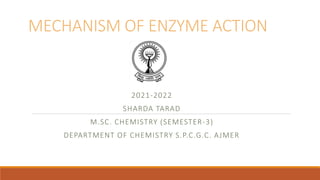
Mechanism of enzyme action
- 1. MECHANISM OF ENZYME ACTION 2021-2022 SHARDA TARAD M.SC. CHEMISTRY (SEMESTER-3) DEPARTMENT OF CHEMISTRY S.P.C.G.C. AJMER
- 2. CONTENT 1. INTRODUCTION OF ENZYMES 2. TRANSITION-STATE THEORY 3. COVALENT CATALYSIS 4. ACID BASE CATALYSIS 5. INTRAMOLECULAR CATALYSIS 6. EXAMPLE OF CHYMOTRYPSIN ENZYME
- 3. INTRODUCTION OF ENZYMES • Biological catalysts • Neither consumed nor permanently altered • All enzymes are proteins in nature except ribozymes which are RNA in nature • Highly efficient • Act as selective catalysts • Site where actual Reaction occurs • Substrate-bound by weak interaction
- 4. MECHANISM OF ENZYME ACTION The catalystic efficiency of enzyme is explained by 2 perspectives: 1.Thermodynamic change 2.Processes at the active site
- 5. • What is transition-state theory? • All chemical reaction have eneygy bariers between reactant and products. • Activational Barrier:- Differnce in energy level of Transitional state and Substrate. SUBSTRATE PRODUCTS
- 6. • Activation Energy:- of a chemical reaction is the minimum energy that is needed to make the reaction happen. • Only a few Substrate can cross this barrier to be converted to Products. • That is why rate of uncatalyzed reaction is much slow. • When enzyme is present it provide an alternate pathway for conversion of Substrate into product. • Enzymes accelerate reaction rate by providing Transtion state with low activational energy for formation of products. • The total energy of the system remains the same equilibrium state is not disturbed
- 8. PROCESS AT THE ACTIVE SITE
- 9. • Enzyme from covalent linkages with substrate forming transient enz-subs complex with very low activational barrier. • Enzyme is then released unchanged and unconsumed and substrate is converted into products.
- 10. ACID BASE CATALYSIS • Mostly undertaken by oxido-reductases. • Mostly at the active site, either histidine is present which act both as a proton donor and a proton acceptor.
- 11. INTRAMOLECULAR CATALYSIS • This mechanism is mostly undertaken by ligases. • The rate of reaction is by bringing substrate closer to each other at the a.site. • A region of high substrate conc. is produced at the active site.. • The substrates molecule is placed at bond forming distances. • Since substrate is placed at optimal distances. • The probability of collision and substrate is eventually converted into products. (ORIENTATION AND STERIC EFFECT)
- 12. Structure of Chymotrypsin Globular single-domain protein. Originally synthesized as a 245 residue protein, chymotrypsinogen. Dipeptides 14-15 and 147-148 are clipped out, transforming the protein into active chymotrypsin. Therefore it has 3 chains (red, blue, green) but these are covalently linked by disulfide bridges. The reactive serine 195 is located in a cleft on the molecule, the active site. Ser195 is adjacent to His57 and Asp102 which are responsible for its reactivity.
- 13. CHYMOTRYPSIN • Serine protease • Catalystic mechanism involves Ser residue. • Utilizes catalytic triad • Asp102-His57-Ser195 • Ser provides nucleophile(o atom) • His acts as base catalyst to activate Ser • Asp stabilizes protonated His • 2-step reaction covalent catalysis
- 14. MECHANISM OF CHYMOTRYPSIN STEP 1: H+ Shift generates Ser-O¯(substrate binding) STEP 2: Ser-O¯binds to C꓿O(Nucleophilic attack) STEP 3: Transition state ׀ STEP 4: Peptide bond breaks
- 15. MECHANISM OF CHYMOTRYPSIN STEP 5: C-Terminal Peptide leaves STEP 6: Ionization of water STEP 7: Transition State װ STEP 8: N-Terminal peptide leaves
- 16. REFERENCES : - • Harper’sIllustrated Biochemistry • Bio-OrganicChemistryby Dr.VinayPrabhaSharma